Cubelium concolor (T.F.Forst.) Raf. ex Britton & A.Br.
Common names:
Eastern Green Violet
Synonyms:
Cubelium concolor (T.F.Forst.) Raf. ex Britton & A.Br., Ill. Fl. N. U.S. 2: 456. 1897; Calceolaria concolor (T.F.Forst.) Kuntze, Revis. gen. pl. 1: 41. 1891; Ionidium concolor (T.F.Forst.) Benth. & Hook.f. ex S.Watson, Bibl. index N. Amer. bot.: 81. 1878; Hybanthus concolor (T.F.Forst.) Spreng., Syst. veg. 1: 805. 1825 ["1824"]; Solea concolor (T.F.Forst.) Ging. ex DC., Prodr. 1: 306. 1824; Cubelium concolor (T.F.Forst.) Raf., First cat. gard. Transylv. Univ.: 13. 1824 [nomen nudum]; Viola concolor T.F.Forst., Trans. Linn. Soc. London 6: 309. 1802. TYPE: ENGLAND: Mr. Forster’s garden from N. America, 1791, [sin collector] (LECTOTYPE (designated by Ballard et al. 2020. Journal of the Botanical Research Institute of Texas 14(2): 218): LINN (LINN-HS1380-26, internet image!). [Forster did not cite a type specimen, but he noted that he had grown a living plant in the garden at the Royal Botanic Garden at Kew for more than 14 years, and later stated that his observations were made on living material and specimens in the Banks Herbarium. He provided a detailed plate with structures illustrated. In addition, a 1791 specimen at LINN (LINN-HS1380-26) has a handwritten notation, "Mr. Forster's garden from N. America", indicating that it is original material; that specimen was designated recently as the lectotype.]
Hybanthus concolor (T.F.Forst.) Spreng. f. subglaber (Eames) Zenkert, Flora of the Niagara Frontier Region: 202. 1934; Cubelium concolor (T.F.Forst.) Raf. f. subglabrum Eames, Rhodora 32: 141. 1930
Noisettia acuminata DC., Prodr. 1: 290. 1824
Viola sprengeliana (Roem. & Schult.) Steud., Nom. Bot.: 887. 1821; Ionidium sprengelianum Roem. & Schult., Syst. Veg., ed. 15, 5: 401. 1819
Solea stricta (Vent.) Spreng., Pl. Min. Cogn. Pug. 1: 22. 1813 [misapplied, Sprengel makes the new combination Solea stricta based on Ionidium strictum Vent. (=P. linearifolia) but also cites Muhlenberg's nomen nudum (=C. concolor), incorrectly applying his new combination in this publication to C. concolor]; Viola stricta Muhl., Trans. Am. Phil. Soc. 3: 178. 1793 [nomen nudum]
Description:
Caulescent perennial, erect from thick horizontal rhizome with branched roots, ≤ 9 dm tall; glabrescent to hirsute; stipules very small, free, linear, entire; leaves several to many, spreading, alternate, blades oblanceolate to narrowly obovate, base cuneate, apex abruptly attenuate, margins entire or irregularly serrate to dentate with 1–2(3) coarse teeth per margin, ≤ 140 × 55 mm, petioles < 1 cm; pedicels 3–10 mm; chasmogamous flower 3–6 mm; sepals narrowly linear, attenuate; corolla green; bottom petal slightly longer than other, blade slightly expanded, retuse at apex; chasmogamous and cleistogamous capsules 15–23 mm long, obovoid, green drying tan, unspotted; seeds 4.5–5.0 × 3.5–4.8 mm, subglobose, tan, unspotted; 2n=48.
Similar species:
None. This species is unique in our region.
Ecology:
Nutrient-rich mesic forests and stabilized floodplains, especially over calcareous limestone or dolomite substrates, also in drier forest microsites where the substrate is alkaline.
Geographic distribution:
Widespread in e. North America, VT to se. MN, south to nw. FL and e. OK.
Conservation concern:
State-listed [as Hybanthus concolor] in CT, DE, IA, MD, MI, MN, NJ, PA, WI.
Phenology:
Chasmogamous flower April–May, chasmogamous fruit May–July, cleistogamous fruit May–October.
Affinities:
Recent comprehensive phylogenetic investigations of the Violaceae family demonstrated that broadly circumscribed Hybanthus was extensively polyphyletic, and that the sole trait of a bottom petal which was saccate at base failed to delineate natural evolutionary groups (Feng 2005; Tokuoka 2008; Wahlert et al. 2014). The majority of New World hybanthoids formed a well supported clade and were subsequently segregated into the resurrected genus Pombalia on the basis of differences in floral and seed features and anatomical traits (Paula-Souza and Ballard 2014). Our temperate eastern North American native hybanthoid now belongs to the resurrected monotypic genus Cubelium, with the genus and species first validly published by Britton and Brown (1897). It is sister to the very small genus Hybanthus sensu stricto from Mesoamerica and the West Indies, that consists of three species of shrubs and treelets. Our Eastern Green Violet differs from Hybanthus sensu stricto in herbaceous habit, highly reduced cymose inflorescence, and several unique floral, fruit, seed and anatomical features.
Hybrids:
None.
Comments:
The genus and species were first validly published by Britton and Brown (1897). It has been accepted as a species under the genus Hybanthus) by Fernald (1950), Henry (1953a), Scoggan (1978), Strausbaugh and Core (1978), Swink and Wilhelm (1979), Gleason and Cronquist (1991), Ballard (1995, 2000, 2013), McKinney and Russell (2002), Haines et al. (2011), Weakley et al. (2012), and Little and McKinney (2015), and under Cubelium by Alexander (1963). Scoggan (1978) recognized f. subglaber but others have synonymized it. Our Eastern Green Violet differs from Hybanthus sensu stricto in herbaceous habit, highly reduced cymose inflorescence, and several unique floral, fruit, seed and anatomical features. This violet is quite nondescript, frequently forming sizeable populations that are nevertheless easily overlooked. I am following Little and McKinney (2015) in using the common name "Eastern Green Violet" to distinguish Cubelium concolor from the vegetatively superficially similar "Western Green Violet", Pombalia attenuata.
Literature cited:
Alexander, E. J. 1963. Violaceae. In Gleason, H. A., The new Britton and Brown illustrated flora of the northeastern United States and adjacent Canada. Hafner Publishing Co., Inc., New York, NY. 552-567.
Ballard Jr., H. E. 1995 ["1994"]. Violets of Michigan. Michigan Botanist 33: 131-199.
Ballard Jr., H. E. 2000. Violaceae. In Rhoads, A. (ed.). Flora of Pennsylvania. University of Pennsylvania Press, Philadelphia, PA. 700-710.
Ballard Jr., H. E. 2013. Violaceae. In Yatskievych, G., Flora of Missouri. Missouri Botanical Garden Press, St. Louis, MO. 1218-1243.
Britton, N. L., and A. Brown. 1897. Violaceae. In An illustrated flora of the northern United States, Canada and the British possessions. Charles Scribner’s Sons, New York, NY. 445-456.
Feng, M. 2005. Floral morphogenesis and molecular systematics of the family Violaceae. PhD dissertation, Ohio University, Athens, OH. 279 pp.
Fernald, M. L. 1950. Violaceae. In Gray’s Manual of Botany, 8th ed. American Book Company, New York, NY. 1022-1042.
Gleason, H. A., and A. Cronquist. 1991. Violaceae. In Manual of vascular plants of northeastern United States and adjacent Canada, 2nd ed. New York Botanical Garden, Bronx, NY. 157-163.
Haines, A., E. Farnsworth, and G. Morrison. 2011. Violaceae. In Flora Novae Angliae. Yale University Press, New Haven, CT. 873-886.
Henry, L. K. 1953a. The Violaceae in western Pennsylvania. Castanea 18(2): 37-59.
Little, R. J., and L. E. McKinney. 2015. Violaceae. In Flora of North America: Cucurbitaceae to Droseraceae, 106. Oxford University Press, New York, NY.
McKinney, L. E., and N. H. Russell. 2002. Violaceae of the southeastern United States. Castanea 67: 369–379.
de Paula-Souza, J. and H. E. Ballard, Jr. 2014. Re-establishment of the name Pombalia, and new combinations from the polyphyletic Hybanthus (Violaceae). Phytotaxa 183(1): 1-15.
Scoggan, H. J. 1978. Violaceae. In Flora of Canada, Part 3–Dicotyledoneae (Saururaceae to Violaceae). National Museums of Canada. Ottawa, Canada. 1103-1115.
Strausbaugh, P. D., and E. L. Core. 1978. Violaceae. In Flora of West Virginia, 2nd ed. Seneca Books, Inc., Morgantown, WV. 644-658.
Swink, F., and G. Wilhelm. 1979. Violaceae. In Plants of the Chicago region, 2nd ed. revised and expanded. Morton Arboretum, Lisle, IL. 384, 801-810.
Tokuoka, T. 2008. Molecular phylogenetic analysis of Violaceae (Malpighiales) based on plastid and nuclear DNA sequences. Journal of Plant Research 121(3): 253-260.
Voss, E. G., and A. A. Reznicek. 2012. Violaceae. In Field manual of Michigan flora. The University of Michigan Press, Ann Arbor, MI. 913-922.
Wahlert, G. A., T. Marcussen, J. de Paula-Souza, M. Feng, and H. E. Ballard, Jr. 2014. A phylogeny of the Violaceae (Malpighiales) inferred from plastid DNA sequences: Implications for generic diversity and intrafamilial taxonomy. Systematic Botany 39: 239-252.
Weakley, A. S., J. C. Ludwig, and J. F. Townsend. 2012. Violaceae. In Flora of Virginia. BRIT Press, Fort Worth, TX. 963-975.
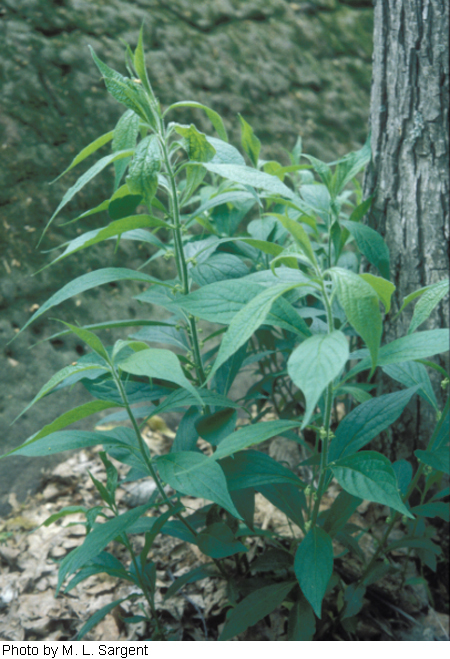
Habit by M. L. Sargent, Morton Arboretum
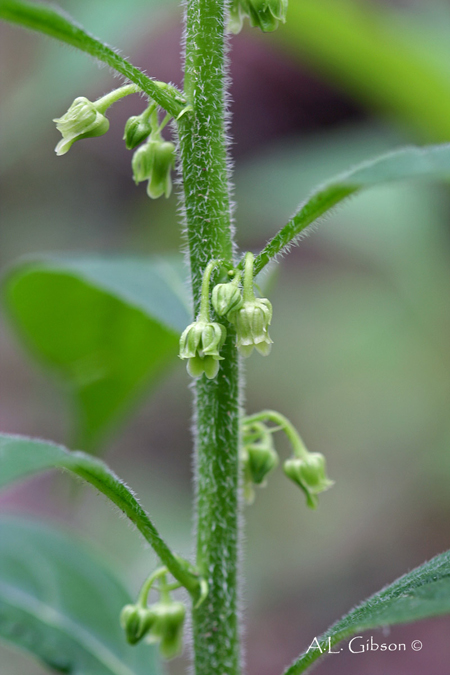
Stem by Andrew Gibson, "Buckeye Botanist" website
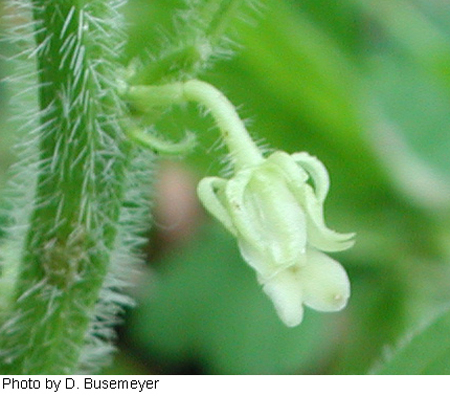
Chasmogamous flower by D. Busemeyer, SERNEC portal
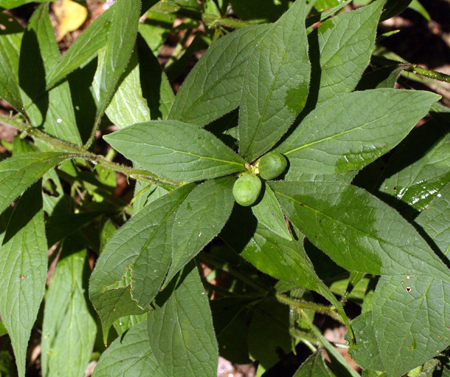
Cleistogamous fruit by Paul Rothrock, SERNEC portal
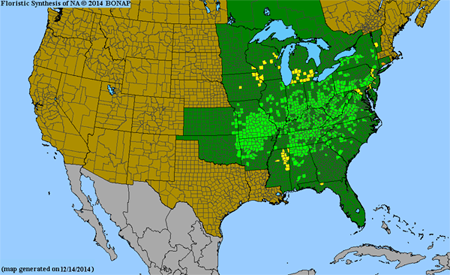
Map by Biota of North America Program